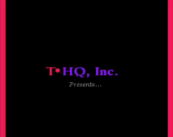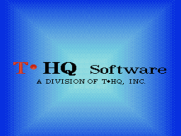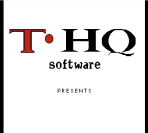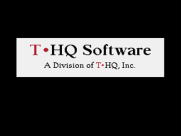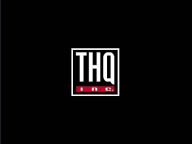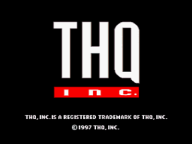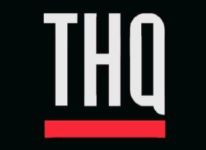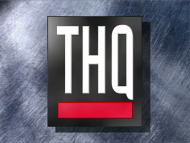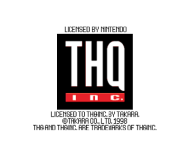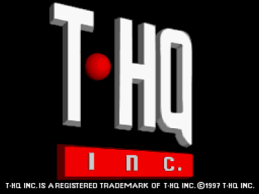Difference between revisions of "THQ"
Jump to navigation
Jump to search
(Created page with "<div class="WPC-editableContent" id="WPC-area?cellId=THQ&version=104&savePath=%2Fpage%2FTHQ&saveType=page"><font size="3"><font><i><font color="#000000"><font colo...") |
|||
| Line 1: | Line 1: | ||
| − | + | < | |
Latest revision as of 16:56, 3 November 2020
Logo descriptions by EnormousRat and Liwakip
Logo captures by wolfie14 and EnormousRat
Video captures by eyadorabi, MotionLibrary, EnormousRat, hydratheme, and JaySticLee
Editions by iheartparamount and others
Background: THQ ("Toy Head-Quarters") was an American developer and publisher founded in 1989 by LJN co-founder Jack Friedman. In 1990, THQ acquired the video game division of Broderbund Software andreleased its first game Peter Pan and the Pirates (based on the Fox Kids TV series of the same name) In 1991. Also in 1991 THQ was acquired by Trinity Acquisition Corporation. In 1994 THQ stopped making toys to focus on video games. THQ acquired several game developers in the 2000s including Relic Entertainment, Volition and many others. In 2008, THQ's troubles began when closed five studios, spun off two studios (Heavy Iron Studios and Incinerator Studios), and sold Big Huge Games to 38 Studios (a company owned by Major League Baseball pitcher Curt Schilling). In 2010, THQ renamed Juice Games and Rainbow Studios to THQ Digital Warrington and THQ Digital Phoenix. In 2011, THQ closed four studios (THQ Studio Australia, Blue Tongue Entertainment, Kaos Studios and THQ Digital Warrington). In 2012, THQ defaulted on a $50 million loan from Wells Fargo. On December 19, 2012, THQ filed for bankruptcy. In January 2013, THQ sold the Homefront franchise to Crytek, Relic Entertainment and the Warhammer 40,000 series to Sega, the WWE series and Evolve (a game from Turtle Rock Studios) to Take-Two Interactive. THQ Montreal and the publishing rights for South Park: The Stick of Truth to Ubisoft, and Volition and the publishing rights the Metro franchise to Koch Media/Deep Silver. In April 2013, THQ's remaining franchises were auctioned off to Nordic Games, while Homeworld was sold to Gearbox Software and Drawn to Life was acquired by 505 Games. Nordic Games later acquired the THQ trademark in 2014, and changed their name to THQ Nordic in 2016 to associate themselves better with the THQ name.
1st Logo
(1991-1993)
Nickname: "Toy Headquarters"
Logo: On a white background, we see the words "T•HQ Software", with a red dot between "T" and "H". There is a byline below them: "A Division of T•HQ, Inc."
Variants:
FX/SFX: None.
Music/Sounds: None. OnThe Adventures of Rocky And Bullwinkle And Friends,a 8-bit rendition of the beginning of the theme can be heard.
Availability: Rare. It can be seen on The Lawnmower Man and aforementioned games. It also appears on Game Boy.
2nd Logo
(November 1994)
Nicknames: "Animals", "The Ren & Stimpy Show: Time Warp Variant", "THQ Box", "The Nick Splat-THQ Box Combo"
Logo: On a black background, 2 pieces of wood can be seen on the top left and bottom right of the screen. Then, Ren pushes in the theNickelodeonSplat logo while Stimpy pushes in a prototype of the next logo.The logo consists of the word "T•HQ" in a white font with a red dot inside a thick white box. Below "T•HQ", there is a red bar with "Inc." on it. When they step on the wood, the planks are sent flying and both of them stand with nervous-looking smiles.
FX/SFX: Ren and Stimpy pushing the logos in.
Music/Sounds: None.
Availability: Seen only on The Ren & Stimpy Show: Time Warp for Super Nintendo Entertainment System.
3rd Logo
(1995-2001)
Nickname: "THQ Box II"
Logo: A glowing red bar with a rippling texture appears and zooms out, sticking to the screen. Then the letters appear one by one: the "T" zooms out from the left, then the "H" zooms in from the middle, then the "Q" zooms out from the right. A lens flare then writes in "Inc." on the bar, causing the texture to disappear. A lens flare then appears behind the logo before 2 more lens flares draw in the square border.
Variants: There are several variants of this logo:
FX/SFX: The logo forming
Music/Sounds: A couple of whooshing and zapping sounds.
Availability: Common on older games, preferably the still version (especially in the early years). The animated version can be seen in games for PC and Playstation such as Rugrats: The Search for Reptar and WCW/NWO Thunder. The animated version is also seen on some Game Boy Color games as well including Disney/Pixar's A Bug's Life and FIFA 2000. The last game with this logo was Power Rangers Lightspeed Rescue.
4th Logo
(1996-1997)
Nickname: "Old-Styled Dot"
Logo: On a black background, the 2nd logo is seen taking up the whole screen, turned at an angle towards the right. There is no border surrounding the logo. Copyright information is shown below the logo.
FX/SFX: None.
Music/Sounds: The game's opening theme.
Availability: Seen in Brunswick World Tournament Champions for SNES. It also appears on The Hunchback of Notre Dame: Topsy Turvy Games and Hercules for Game Boy.
5th Logo
(June 1, 2000-2011)
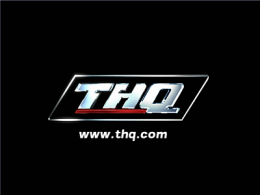
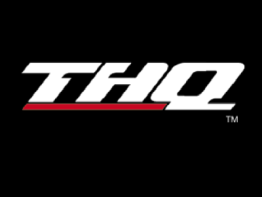
<embed allowfullscreen="true" height="224" src="http://wikifoundrytools.com/wiki/closinglogos/widget/youtubevideo/48b191e00594ad92f53b19d6b58c8b6885e4465c" type="application/x-shockwave-flash" width="272" wmode="transparent"/>
Nicknames: "T-H-Q!", "The Parallelogram"
Logo: On a black background, a steel parallelogram is formed with parts of it being sliced off, and it flashes. A larger outline of the parallelogram appears outside it, and 3 silver letters with cuts in them ("T" and "Q" from right, "H" from left) slide onto the parallelogram. A red bar appears from left and bumps into the shield, making it sway and completing the logo. The company website address fades in below, and the shield border shines.
Variants:
FX/SFX: The whole animation.
Music/Sounds: Synthesized whooshes, followed by a male announcer saying "T-H-Q!" where the correct letters appear. An electronic buzzing sound is heard as the shield shines.
Logo captures by wolfie14 and EnormousRat
Video captures by eyadorabi, MotionLibrary, EnormousRat, hydratheme, and JaySticLee
Editions by iheartparamount and others
Background: THQ ("Toy Head-Quarters") was an American developer and publisher founded in 1989 by LJN co-founder Jack Friedman. In 1990, THQ acquired the video game division of Broderbund Software andreleased its first game Peter Pan and the Pirates (based on the Fox Kids TV series of the same name) In 1991. Also in 1991 THQ was acquired by Trinity Acquisition Corporation. In 1994 THQ stopped making toys to focus on video games. THQ acquired several game developers in the 2000s including Relic Entertainment, Volition and many others. In 2008, THQ's troubles began when closed five studios, spun off two studios (Heavy Iron Studios and Incinerator Studios), and sold Big Huge Games to 38 Studios (a company owned by Major League Baseball pitcher Curt Schilling). In 2010, THQ renamed Juice Games and Rainbow Studios to THQ Digital Warrington and THQ Digital Phoenix. In 2011, THQ closed four studios (THQ Studio Australia, Blue Tongue Entertainment, Kaos Studios and THQ Digital Warrington). In 2012, THQ defaulted on a $50 million loan from Wells Fargo. On December 19, 2012, THQ filed for bankruptcy. In January 2013, THQ sold the Homefront franchise to Crytek, Relic Entertainment and the Warhammer 40,000 series to Sega, the WWE series and Evolve (a game from Turtle Rock Studios) to Take-Two Interactive. THQ Montreal and the publishing rights for South Park: The Stick of Truth to Ubisoft, and Volition and the publishing rights the Metro franchise to Koch Media/Deep Silver. In April 2013, THQ's remaining franchises were auctioned off to Nordic Games, while Homeworld was sold to Gearbox Software and Drawn to Life was acquired by 505 Games. Nordic Games later acquired the THQ trademark in 2014, and changed their name to THQ Nordic in 2016 to associate themselves better with the THQ name.
1st Logo
(1991-1993)
Nickname: "Toy Headquarters"
Logo: On a white background, we see the words "T•HQ Software", with a red dot between "T" and "H". There is a byline below them: "A Division of T•HQ, Inc."
Variants:
- On Fox's Peter Pan and the Pirates, the logo reads "T•HQ, Inc.", and "Presents..." below.
- On Wayne's World, the logo reads "T•HQ software", and "PRESENTS" below.
- On The Ren & Stimpy Show: Veediots!, the logo reads "T•HQ, Inc.", and "TOY HEADQUARTERS" below. Under it, we see Ren and Stimpy banging their butts together.
- On The Great Waldo Search, the background is gradient blue.
- On Road Riot 4WD, the background is red and the copyright info is taken into brackets.
- The Adventures of Rocky And Bullwinkle And Friendsvariant is almost the same as Wayne's World variant, but it's higher-quality and "PRESENTS" is located far more below.
FX/SFX: None.
Music/Sounds: None. OnThe Adventures of Rocky And Bullwinkle And Friends,a 8-bit rendition of the beginning of the theme can be heard.
Availability: Rare. It can be seen on The Lawnmower Man and aforementioned games. It also appears on Game Boy.
2nd Logo
(November 1994)
Nicknames: "Animals", "The Ren & Stimpy Show: Time Warp Variant", "THQ Box", "The Nick Splat-THQ Box Combo"
Logo: On a black background, 2 pieces of wood can be seen on the top left and bottom right of the screen. Then, Ren pushes in the theNickelodeonSplat logo while Stimpy pushes in a prototype of the next logo.The logo consists of the word "T•HQ" in a white font with a red dot inside a thick white box. Below "T•HQ", there is a red bar with "Inc." on it. When they step on the wood, the planks are sent flying and both of them stand with nervous-looking smiles.
FX/SFX: Ren and Stimpy pushing the logos in.
Music/Sounds: None.
Availability: Seen only on The Ren & Stimpy Show: Time Warp for Super Nintendo Entertainment System.
3rd Logo
(1995-2001)
<embed allowfullscreen="true" height="185" src="http://wikifoundrytools.com/wiki/closinglogos/widget/youtubevideo/a037e2b48cc59d073ad8a9da44f4af452cd93407" type="application/x-shockwave-flash" width="226" wmode="transparent"/><embed allowfullscreen="true" height="184" src="http://wikifoundrytools.com/wiki/closinglogos/widget/youtubevideo/f392e33f7b054c210a84c7fa6a3ec7bcf069503c" type="application/x-shockwave-flash" width="222" wmode="transparent"/><embed allowfullscreen="true" height="184" src="http://wikifoundrytools.com/wiki/closinglogos/widget/youtubevideo/84f337efd7964ac2dd901fefbc8300c7680ce754" type="application/x-shockwave-flash" width="224" wmode="transparent"/>
Nickname: "THQ Box II"
Logo: A glowing red bar with a rippling texture appears and zooms out, sticking to the screen. Then the letters appear one by one: the "T" zooms out from the left, then the "H" zooms in from the middle, then the "Q" zooms out from the right. A lens flare then writes in "Inc." on the bar, causing the texture to disappear. A lens flare then appears behind the logo before 2 more lens flares draw in the square border.
Variants: There are several variants of this logo:
- On weak platforms (which have no enough capacity to play video), the logo is still.
- On Sinistar, the animation is different. "THQ" and the rest of the logo zooms out in pieces and stick together over a blue metallic background with several scratches. Here, the text is taken into a black box and the red line is blank. The background then disappears and "PRESENTS" spreads out below the logo.
- On X: Beyond the Frontier, the logo is rendered with the in-game engine, forming through several glass planes.
- On Timon & Pumbaa's Jungle Games, the box is omitted.
- On SNES and Genesis versions of Madden NFL '98 and NBA Live '98 as well as some EA Sports and Disney titles for Game Boy, there is no box, but the copyright information is also shown below.
- On Penny Racers, the background is white and we see the copyright information from Nintendo and Takara.
- On Destruction Derby for Nintendo 64, the red bar is empty. This is also seen on Game Boy Color.
FX/SFX: The logo forming
Music/Sounds: A couple of whooshing and zapping sounds.
- On X, there is a trumpet fanfare ending with a single hit.
- On Sinistar, there is a mysterious windchime pass.
- The still variant is silent.
Availability: Common on older games, preferably the still version (especially in the early years). The animated version can be seen in games for PC and Playstation such as Rugrats: The Search for Reptar and WCW/NWO Thunder. The animated version is also seen on some Game Boy Color games as well including Disney/Pixar's A Bug's Life and FIFA 2000. The last game with this logo was Power Rangers Lightspeed Rescue.
4th Logo
(1996-1997)
Nickname: "Old-Styled Dot"
Logo: On a black background, the 2nd logo is seen taking up the whole screen, turned at an angle towards the right. There is no border surrounding the logo. Copyright information is shown below the logo.
FX/SFX: None.
Music/Sounds: The game's opening theme.
Availability: Seen in Brunswick World Tournament Champions for SNES. It also appears on The Hunchback of Notre Dame: Topsy Turvy Games and Hercules for Game Boy.
5th Logo
(June 1, 2000-2011)


<embed allowfullscreen="true" height="224" src="http://wikifoundrytools.com/wiki/closinglogos/widget/youtubevideo/48b191e00594ad92f53b19d6b58c8b6885e4465c" type="application/x-shockwave-flash" width="272" wmode="transparent"/>
Nicknames: "T-H-Q!", "The Parallelogram"
Logo: On a black background, a steel parallelogram is formed with parts of it being sliced off, and it flashes. A larger outline of the parallelogram appears outside it, and 3 silver letters with cuts in them ("T" and "Q" from right, "H" from left) slide onto the parallelogram. A red bar appears from left and bumps into the shield, making it sway and completing the logo. The company website address fades in below, and the shield border shines.
Variants:
- A still print version exists on Nintendo 64 games and other platforms.
- A shield-less version was seen onRugrats in Parisfor N64 and PS--probably the first appearance of this logo. The same version, only smaller, was used onChampionship Motocrossfor PS.
- On the GBA version ofThe Incredibles, the logo animates on a white background, the border and web address already formed, and the border doesn't sway. It then all flies away for the Helixe logo.
- OnRugrats: Royal Ransom, SpongeBob SquarePants: Employee of the Month, Splashdown: Rides Gone WildandScooby-Doo! Night of 100 Frights, the website address is eliminated.
Music/Sounds: Synthesized whooshes, followed by a male announcer saying "T-H-Q!" where the correct letters appear. An electronic buzzing sound is heard as the shield shines.
Music/Sounds variant: On non-US releases of Rugrats in Paris (the PC game), the normal sound effects are replaced with cartoon sounds, which consists of a whirl, a whizzing sound, a bonk sound, and another whirl, all as the letters appear. Additionally, the THQ name is uttered by a group of kids instead, and the famousHanna-Barberaboingsound is heard when the red bar appears (likely a nod to the 1998Klasky Csupo“Splaat" logo), where the logo then falls to silence.
Availability: Common on games from the time. This can be seen on Game Boy Advance and Nintendo DS games, including SpongeBob's Truth or Square. The first games to use this were SpongeBob SquarePants: Operation Krabby Patty and Rugrats All Growed Up: Older and Bolder. It also appears on Rugrats Go Wild (the PC game) and Spirit: Stallion of the Cimarron - Forever Free.
6th Logo
(2003-2011)
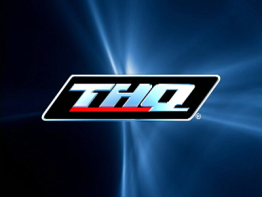 <embed align="bottom" allowfullscreen="true" height="197" src="http://wikifoundrytools.com/wiki/closinglogos/widget/youtubevideo/8e37e3950ac2e186d9e72d8ba47c8c174f97e62a" type="application/x-shockwave-flash" width="245" wmode="transparent"/>
<embed align="bottom" allowfullscreen="true" height="197" src="http://wikifoundrytools.com/wiki/closinglogos/widget/youtubevideo/8e37e3950ac2e186d9e72d8ba47c8c174f97e62a" type="application/x-shockwave-flash" width="245" wmode="transparent"/>
Nicknames: "The Light-Striking Parallelogram", "The Parallelogram II"
Logo: A silver-blue "H" letter flips around onto a black background, filled with blue lights and lasers. The rest of the logo then slides in, with the border zooming out. Electricity is also seen charging on the logo. After a shine and a few seconds, the border flips towards the screen and the letters zoom in one by one, ending the logo.
FX/SFX: Pretty much everything.
Music/Sounds: Many whooshes and some electric sounds.
Availability: Common, used occasionally alongside the other "shield" logos; it is known to appear in Juiced, the Tak and the Power of Juju trilogy,and many PSP releases. It can be seen on the PC games ofBratz 4 Real, Bratz: Rock Angelz and Scooby-Doo 2: Monsters Unleashed.
7th Logo
(2003-February 22, 2011)
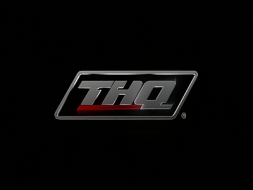 <embed allowfullscreen="true" height="183" src="http://wikifoundrytools.com/wiki/closinglogos/widget/youtubevideo/bc0a520f53690b44c12838d931e1c854b134729e" type="application/x-shockwave-flash" width="220" wmode="transparent"/>
<embed allowfullscreen="true" height="183" src="http://wikifoundrytools.com/wiki/closinglogos/widget/youtubevideo/bc0a520f53690b44c12838d931e1c854b134729e" type="application/x-shockwave-flash" width="220" wmode="transparent"/>
Nicknames: "The Streaks", "The Parallelogram III"
Logo: On a black background, the logo is seen darkened sans the border, rotating around while surrounded by several streaks of white and red light. The streaks then strike the border, illuminating the logo one part at a time before shining.
Variants: Go to thispage.
FX/SFX: The rotating of the logo, the comets.
Music/Sounds: The comet whooshing and blasts.
Availability: Common in every game up to 2011, like Warhammer 40000: Dawn of War. The last game to use this logo is De Blob 2 (February 2011), which uses this logo in-game but the next logo on its box art.
8th Logo
(February 2011-November 30,2012)
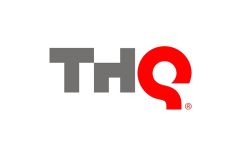
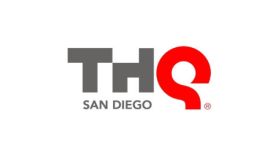
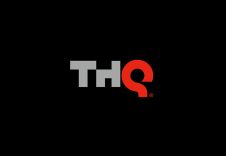
<embed allowfullscreen="true" height="217" src="http://wikifoundrytools.com/wiki/closinglogos/widget/youtubevideo/edd6f88ca7a1d3b4625ad230915708ded39663ca" type="application/x-shockwave-flash" width="262" wmode="transparent"/>
Logo: On a white background, a grey line slides in, which turns into a large red curve drawing upwards. The camera zooms out to reveal it is a abstract red "Q". A grey line then emerges from it, causing the"Q" to go left and the line to sprout into a large grey square. It splits to form "TH", with the latter missing the top left part of it. They form "THQ" while a red registered trademark symbol appears to the bottom right of it.
Variant:The internal studios have their subnames in gray under the main logo.
FX/SFX: The animation.
Music/Sounds: A deep whoosh sound similar to wind blowing, ending with two silent bumps.
Availability: Appeared on all THQ games from February 2011 to their final games in late 2012; Homefront and WWE All Stars were among the first ones. Technically, this logo made its first retail appearance on the box art of De Blob 2, despite the previous logo being used in-game.
Availability: Common on games from the time. This can be seen on Game Boy Advance and Nintendo DS games, including SpongeBob's Truth or Square. The first games to use this were SpongeBob SquarePants: Operation Krabby Patty and Rugrats All Growed Up: Older and Bolder. It also appears on Rugrats Go Wild (the PC game) and Spirit: Stallion of the Cimarron - Forever Free.
6th Logo
(2003-2011)
 <embed align="bottom" allowfullscreen="true" height="197" src="http://wikifoundrytools.com/wiki/closinglogos/widget/youtubevideo/8e37e3950ac2e186d9e72d8ba47c8c174f97e62a" type="application/x-shockwave-flash" width="245" wmode="transparent"/>
<embed align="bottom" allowfullscreen="true" height="197" src="http://wikifoundrytools.com/wiki/closinglogos/widget/youtubevideo/8e37e3950ac2e186d9e72d8ba47c8c174f97e62a" type="application/x-shockwave-flash" width="245" wmode="transparent"/>Nicknames: "The Light-Striking Parallelogram", "The Parallelogram II"
Logo: A silver-blue "H" letter flips around onto a black background, filled with blue lights and lasers. The rest of the logo then slides in, with the border zooming out. Electricity is also seen charging on the logo. After a shine and a few seconds, the border flips towards the screen and the letters zoom in one by one, ending the logo.
FX/SFX: Pretty much everything.
Music/Sounds: Many whooshes and some electric sounds.
Availability: Common, used occasionally alongside the other "shield" logos; it is known to appear in Juiced, the Tak and the Power of Juju trilogy,and many PSP releases. It can be seen on the PC games ofBratz 4 Real, Bratz: Rock Angelz and Scooby-Doo 2: Monsters Unleashed.
7th Logo
(2003-February 22, 2011)
 <embed allowfullscreen="true" height="183" src="http://wikifoundrytools.com/wiki/closinglogos/widget/youtubevideo/bc0a520f53690b44c12838d931e1c854b134729e" type="application/x-shockwave-flash" width="220" wmode="transparent"/>
<embed allowfullscreen="true" height="183" src="http://wikifoundrytools.com/wiki/closinglogos/widget/youtubevideo/bc0a520f53690b44c12838d931e1c854b134729e" type="application/x-shockwave-flash" width="220" wmode="transparent"/>Nicknames: "The Streaks", "The Parallelogram III"
Logo: On a black background, the logo is seen darkened sans the border, rotating around while surrounded by several streaks of white and red light. The streaks then strike the border, illuminating the logo one part at a time before shining.
Variants: Go to thispage.
FX/SFX: The rotating of the logo, the comets.
Music/Sounds: The comet whooshing and blasts.
Availability: Common in every game up to 2011, like Warhammer 40000: Dawn of War. The last game to use this logo is De Blob 2 (February 2011), which uses this logo in-game but the next logo on its box art.
8th Logo
(February 2011-November 30,2012)



<embed allowfullscreen="true" height="217" src="http://wikifoundrytools.com/wiki/closinglogos/widget/youtubevideo/edd6f88ca7a1d3b4625ad230915708ded39663ca" type="application/x-shockwave-flash" width="262" wmode="transparent"/>
Logo: On a white background, a grey line slides in, which turns into a large red curve drawing upwards. The camera zooms out to reveal it is a abstract red "Q". A grey line then emerges from it, causing the"Q" to go left and the line to sprout into a large grey square. It splits to form "TH", with the latter missing the top left part of it. They form "THQ" while a red registered trademark symbol appears to the bottom right of it.
Variant:The internal studios have their subnames in gray under the main logo.
FX/SFX: The animation.
Music/Sounds: A deep whoosh sound similar to wind blowing, ending with two silent bumps.
Availability: Appeared on all THQ games from February 2011 to their final games in late 2012; Homefront and WWE All Stars were among the first ones. Technically, this logo made its first retail appearance on the box art of De Blob 2, despite the previous logo being used in-game.
